 | |
|
An up close and personal interview with U.S. Navy Veteran and Togetherweserved.com Member:
OS2 William Cooper (1972-1975)
WHAT INFLUENCED YOUR DECISION TO JOIN THE MILITARY?
 I joined the Navy in particular because I had several uncles who had served during WWII. Two rising to the rank of CPO and one, a TM2, dying when his submarine USS Grayling SS-209 was lost in action off the Philippines. My father served during WWII as an engineering officer on several "Liberty" and "Victory" freighters. During my childhood, I heard many stories of their exploits and it appealed to me very much. When a friend of mine suggested that we join up I was ready. My friend spent the next (20) years in the Navy. He was ADCS Clifford L. Newton (deceased). I joined the Navy in particular because I had several uncles who had served during WWII. Two rising to the rank of CPO and one, a TM2, dying when his submarine USS Grayling SS-209 was lost in action off the Philippines. My father served during WWII as an engineering officer on several "Liberty" and "Victory" freighters. During my childhood, I heard many stories of their exploits and it appealed to me very much. When a friend of mine suggested that we join up I was ready. My friend spent the next (20) years in the Navy. He was ADCS Clifford L. Newton (deceased).
WHAT WAS YOUR SERVICE CAREER PATH?
As everyone did, I began basic training which for me was NTC San Diego. Following that, I reported to NTC Great Lakes for RD-A (Radarman "A") school. Because I graduated at the top of my class I was able to pick my duty station. DLG-23 (Destroyer Leader Guided Missile Frigate USS Halsey. DLG was later changed to CG or Guided Missile Cruiser in 1975 to more accurately reflect the ships mission in relation to our NATO allies) was being refitted in Bath, Maine and I chose her. I quickly discovered that my contemporaries were also "top of the line" and we all rose quickly to PO3 and then PO2. I was given many assignments by my superiors and excelled at these assigned tasks. To the consternation of some of my buddies, I was the first to be sent to ASAC (Anti-Submarine Air Control) school and then to AIC (Air Intercept Control) school. By the end of my 4th year of service and the end of my enlistment, I wanted to return to my family and back to college at my home in Colorado, which I did.
DID YOU PARTICIPATE IN COMBAT OPERATIONS? IF SO, COULD YOU DESCRIBE THOSE WHICH WERE SIGNIFICANT TO YOU?
Patrolling the waters of the Tonkin Gulf in the early 1970's. I particularly remember being assigned as a PIRAZ (Positive Identification Radar Advisory Zone) air controller.
SOUTH CHINA SEA  SUBMARINE CONTACT SUBMARINE CONTACT
It was about 14:00 hours. I was in CIC (Combat Information Center) on watch on the big SPA-50 repeater linked to the SPS-10 (SPA and SPS are Navy nomenclature prefixes) surface radar doing "surface search" looking for any surface contacts in the vicinity of our ship. We were out in the South china Sea off the coast of Vietnam and there wasn't anything going on, vessel wise, near us so things were very relaxed. It was a calm day with very little wind so the sea was relatively smooth and flat so that anything that was on the surface of the sea was easily detectible on the surface radar.
I was sitting on the big stool in front of the radar repeater but was sitting at a 90-degree angle to the scope shooting the "bull" with the other watch standers in CIC. I kept one eye on the scope and watched as the sweep made monotonous sweeps round and round on the scope without so much as clutter for contacts.
Suddenly, a very good "paint" of a contact from the radar showed up on the scope. I turned back to the scope and marked the contacts position on the scope with a grease pencil. The radar continued its sweep and again there was this good paint on the radar. I again marked its position on the scope and asked the guys on the DRT (Dead Reckoning Tracer) and NC2 (A tracer like the DRT, but with slaved inputs from different sensor sources) to start a plot. I notified the bridge via sound powered phone that I had a "pop-up" contact, gave them the bearing and range and advised them that we had started a plot.
The contact remained for maybe 8 to 10 revolutions of the radar and then disappeared. I had been marking each radar paint of the contact with a grease pencil on the scope head and passing range and bearing information to the plotters on the DRT and NC2. They confirmed that this contact was moving on a definite course and speed. Because it had suddenly appeared and then just as suddenly disappeared I, and the others in CIC, figured it just might be a submarine.
As soon as the contact disappeared, I advised the CIC officer that I thought this was a possible submarine contact and asked permission to call for S-2 Tracker aircraft from the aircraft carrier that was in the vicinity to confirm my suspicions about the contact. The S-2 aircraft carried MAD (Magnetic Anomaly Detection) gear on board and if directed over the plotted course of the contact could confirm if I was right about this contact being a sub.
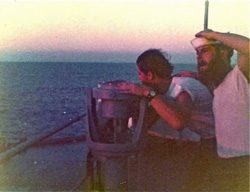 My request was okayed and I promptly got on the radio and called for the S-2s. In about 10 minutes I was on the radio with two S-2s and vectored them in to cross the point where I had DRed (dead reckoned) on the scope head the possible submarine to be. As soon as the leading S-2 flew over my DR point he called,"MAD, MAD, MAD" on the radio which meant that his MAD gear had confirmed that there was a very large metal object down there. The second S-2 confirmed the first aircraft's MAD as he flew over the track. My CIC officer reported to the bridge that we had a sub on the hook and were tracking him with S-2s. My request was okayed and I promptly got on the radio and called for the S-2s. In about 10 minutes I was on the radio with two S-2s and vectored them in to cross the point where I had DRed (dead reckoned) on the scope head the possible submarine to be. As soon as the leading S-2 flew over my DR point he called,"MAD, MAD, MAD" on the radio which meant that his MAD gear had confirmed that there was a very large metal object down there. The second S-2 confirmed the first aircraft's MAD as he flew over the track. My CIC officer reported to the bridge that we had a sub on the hook and were tracking him with S-2s.
"Now set condition 1AS, this is not a drill" came over the 1MC (1AS means that the ship is rigged and battle stations set for anti-submarine warfare. The 1MC is a ship wide public address system). Everyone in CIC was alert and excited. I kept watching the scope hoping that the sub would stick his periscope or an antenna up again, but I never saw anymore radar paints. I kept driving the S-2s over the DR track and they continued to call MAD each time they passed over the projected position I plotted. I asked for (2) "dipping" helos (helicopters with sonar heads that can be lowered into the water at differing points to actively pinpoint a subs location) and was told that they'd be enroute shortly. Captain Nolan, CO of our ship, came into CIC and gave me an "atta boy" which really made my day. I was having so much fun that I didn't realize that two hours had passed and it was time to relieve the watch. My relief was there so I turned over my ASAC (anti-submarine air control) of the S-2s to my relief, advised him that (2) dipping helos would be up and on station shortly, gave him a rundown of all that had transpired on my watch and went down to the mess deck for chow. I felt great.
It was determined that there were no friendly subs in the area and that the sub we found and chased was probably a "Whiskey" class soviet diesel boat as they sometimes transited through that area. My watch relief continued to prosecute the sub with aircraft for several more hours, but I had found him and with the team effort of all those in CIC we made that sub aware that we were on his butt.
HARASSING THE COMMIES
 We were steaming in the South China Sea off the coast of Vietnam aboard USS Halsey DLG-23. It was later in the afternoon of a bright and sunny day. I wasn't on watch and I had heard on the 0800-1200 watch that we could expect to encounter a soviet convoy transiting our operating area sometime in the afternoon. We were steaming in the South China Sea off the coast of Vietnam aboard USS Halsey DLG-23. It was later in the afternoon of a bright and sunny day. I wasn't on watch and I had heard on the 0800-1200 watch that we could expect to encounter a soviet convoy transiting our operating area sometime in the afternoon.
One of my collateral duties was to keep all the navigational charts in CIC up to date using the weekly publication "Notice to Mariners". The Notice to Mariners is a publication that lists all the hazards to navigation which have occurred anywhere in the world and have been reported. Hazards can include sunken ships, sand bar obstructions due to severe weather, new navigational buoys in harbors, etc. Anyway, I was sitting at the chart desk over in the corner of CIC working to update the charts we (the CIC low visibility piloting team) would need to operate for the next week. Someone from the surface plot called out that they had several contacts close together heading in a southerly direction to the northwest of our current position.
I remember that we were southeast of these contacts at the time and as word went to the bridge of their range and bearing, I felt the ship start to shudder as all engines were brought to "All ahead full". The ship started to lay over a bit as we turned to intercept the contacts, and since I was off watch, I wanted to see what was up.
We studied up on a course that would give us a CPA (closest point of approach) close astern of the last contact in the line of contacts. WE WERE HAULIN' ASS. I left CIC and went out on the bridge. Captain Nolan was there, smiling and looking through his binoculars. I went out and up to the O4 level to get a better view as we were closing on these contacts very quickly and would be on them soon. I wasn't the only one. Anyone who wasn't on duty was out on deck. We were in our usual tropical uniform of the day, dungaree pants, t-shirts, white hats and boon dockers.
Over the 1MC an announcement came from Captain Nolan that we were closing on a soviet convoy which consisted of a couple of cruisers towing diesel submarines and two auxiliary vessels for a total of (6) ships. At that time it was a common practice for the soviet navy to tow their diesel subs, especially on long voyages, as a way to conserve fuel.
We were all grinning. From the O4 level I could see the ships as they became bigger and bigger as we rushed at them. As we got closer we could see that the sailors of the soviet ships were "manning the rails" in dress uniforms. We also could see that all of the ships radar and communication antennae were directed away from us.
 I don't remember now what the minimum CPA, as promulgated by the Captain's Standing Order was, but we went around the trailing ship at maybe a 100 yards and probably 30 knots! I'm sure the Soviets were nervous. Hell, I was nervous as Captain Nolan skillfully cranked us around to port and slowed to parallel them at their slow pace. We were all hooting and hollering and taking pictures as we were very close aboard. It was striking to see the contrast between them and us. The soviets in a slow procession towing their old diesel subs, manning the rails in their best uniforms and nervous about us. We, in our clean, sleek and fast USS Halsey steaming next to them wearing our tropical working uniform with many, like me, sporting full beards, mocking them, confident and having one hell of a good time. I don't remember now what the minimum CPA, as promulgated by the Captain's Standing Order was, but we went around the trailing ship at maybe a 100 yards and probably 30 knots! I'm sure the Soviets were nervous. Hell, I was nervous as Captain Nolan skillfully cranked us around to port and slowed to parallel them at their slow pace. We were all hooting and hollering and taking pictures as we were very close aboard. It was striking to see the contrast between them and us. The soviets in a slow procession towing their old diesel subs, manning the rails in their best uniforms and nervous about us. We, in our clean, sleek and fast USS Halsey steaming next to them wearing our tropical working uniform with many, like me, sporting full beards, mocking them, confident and having one hell of a good time.
It was obvious to us who were there. We were the elite, the professionals. Our ship was clean, sleek, fast and maneuvered like a finely tuned Swiss watch and skippered by a man who made us proud. THEY, the soviets, were towing old, outdated diesel submarines with major surface combatants that had rust streaks down their sides. They need not have turned their radar and communication antennae away from us as we already knew what they had and the capabilities and limits of each system.
We didn't need to show off. We knew and they knew. We were the "Bull", and they had just been mounted.
WHICH, OF THE VESSELS OR DUTY STATIONS YOU WERE ASSIGNED TO, DO YOU HAVE THE FONDEST MEMORIES OF AND WHY?
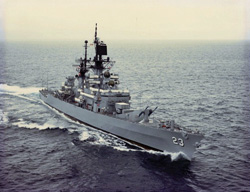 USS Halsey DLG/CG-23 was the only ship I served on during my four years of active duty. The people, both contemporaries and mentors/superiors, were wonderful people who helped shape my views and attitudes and I am a much better person for having known them. I have remained friends with some of them for all these intervening years. USS Halsey DLG/CG-23 was the only ship I served on during my four years of active duty. The people, both contemporaries and mentors/superiors, were wonderful people who helped shape my views and attitudes and I am a much better person for having known them. I have remained friends with some of them for all these intervening years.
FROM YOUR ENTIRE SERVICE CAREER WHAT PARTICULAR MEMORY STANDS OUT?
That would be an experience I had in early 1973 while sitting at a SPA-50 repeater in CIC calling range and bearing to surface contacts. We were off Guantanamo, Cuba doing radar ranging and calibration. We had "observers" aboard to see how we reacted to different "casualties" of the radar and associated equipment. Everyone in CIC was busy doing something and one of the "observers" came over to me and said, "You're being electrocuted". I looked at him in amazement and stated that I was fine. He looked at me with a very stern look and said, "You're being electrocuted, now act like it". I grabbed the big repeater with both hands and started hollering VERY loudly. Senior Chief Troy Goodman, who had been doing something else, but was close by, immediately ran over and knocked me right off my stool with his fist. As I lay on the deck stunned, Senior Chief looked down at me and asked, "Are you crazy?" The observer stepped in and explained that he had instructed me to act as though electrocuted and although unorthodox, Senior Chief's method of "unhinging" me from the device was effective. Senior Chief replied, "Good, I thought the bastard had gone nuts!"
OF THE MEDALS, AWARDS AND QUALIFICATION BADGES OR DEVICES YOU RECEIVED, WHAT IS THE MOST MEANINGFUL TO YOU AND WHY?
Getting the designator for AIC (Air Intercept Controller) 0318 meant the most to me. That school really stressed me out. It made the sweat beads pop out sometimes, particularly if I was using the SPS-43 radar. The "paints" on that radar were these long sweeping arcs and it was sometimes very difficult to discern aircraft from clouds and clutter.
WHICH INDIVIDUAL PERSON FROM YOUR SERVICE STANDS OUT AS THE ONE WHO HAD THE BIGGEST IMPACT ON YOU AND WHY?
 OSCM Troy Goodman without a doubt. He had great confidence in me and guided me through some difficult times that I was having personally, while making me better professionally. He gave me confidence and taught me how to be a professional. His lessons carried through very well in my civilian life. There were other good mentors too, but he was a true inspiration for me in all that he did. OSCM Troy Goodman without a doubt. He had great confidence in me and guided me through some difficult times that I was having personally, while making me better professionally. He gave me confidence and taught me how to be a professional. His lessons carried through very well in my civilian life. There were other good mentors too, but he was a true inspiration for me in all that he did.
CAN YOU RECOUNT A PARTICULAR INCIDENT FROM YOUR SERVICE THAT WAS FUNNY AT THE TIME AND STILL MAKES YOU LAUGH?
This wasn't funny at the time, at least until I had time to think about it some. Halsey was tied up next to the pier at 32nd Street Naval Station in San Diego. We'd been in port awhile and things were humming along as usual. The brow was across on the starboard side O1 level aft by the missile launcher. I was assigned as the "Petty Officer of the Watch" and as such was supposed to help the "Officer of the Watch", one DS1(Data Systems Tech 1st Class) Marcotte, monitor ALL who came aboard Halsey for proper security. I was in my whites and had my ACP.45 strapped on and was thinking how important I felt with it there. DS1 Marcotte was busy doing what he did.
It was about 1500 and things were getting very busy on the quarterdeck. We were keeping up with the number of persons coming aboard, but just barely, when I noticed a nervous little CPO (Chief Petty Officer) come across the brow, he saluted as he walked but then quickly went around behind the missile launcher at a quick pace without coming first to the quarterdeck to check in. I told DS1 I'd better go see who this CPO was as I didn't recognize him. I got a "whatever" from DS1 and I went quickly over to the port side and up the ladder to the O2 level.
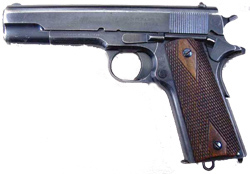 As I topped the ladder I could see the little Chief walking briskly forward. I didn't want to run after him so I yelled "HALT!" That poor little Chief threw up his hands, jumped and turned around yelling, "Don't shoot!, Don't shoot!". His actions SCARED ME TO DEATH. I fumbled for my .45 and for the clip of ammo to load it. I slammed the clip in and pointed the .45 at the chief. That Chief was scared, I was scared and tongue tied, so just pointed for the Chief to head for the quarterdeck. As I topped the ladder I could see the little Chief walking briskly forward. I didn't want to run after him so I yelled "HALT!" That poor little Chief threw up his hands, jumped and turned around yelling, "Don't shoot!, Don't shoot!". His actions SCARED ME TO DEATH. I fumbled for my .45 and for the clip of ammo to load it. I slammed the clip in and pointed the .45 at the chief. That Chief was scared, I was scared and tongue tied, so just pointed for the Chief to head for the quarterdeck.
The Chief went down the ladder and I followed. He was telling me the whole time that he was from INSURV (Navy Board of Inspection and Survey) or somewhere and that he had come aboard to check our security. He continued to babble on to DS1, but I was still shaking like a leaf and don't remember a thing he said.
It turned out that DS1 and I got pats on the back for stopping the intruder who had indeed been sent to see if our security was lacking. I could smile weakly about it then, but laugh out loud now when I think of that little Chief throwing up his hands, yelling and jumping like a shot deer. I also remember how scared I was.
WHAT PROFESSION DID YOU FOLLOW AFTER THE SERVICE AND WHAT ARE YOU DOING NOW? IF CURRENTLY SERVING, WHAT IS YOUR CURRENT JOB?
I went back to college after leaving the Navy. I intended to get a degree in "Professional Piloting". I have enjoyed flying since I got out of the Navy. I got my private license in 1977 and thought that maybe I'd make flying a career.
I also applied for a job  with a large metropolitan fire department in the Denver area. I took all the tests for fire recruit and was told,"We'll let you know". After almost a year and a half I got a phone call from Deputy Chief Brehm (Deputy Chief of Operations) asking was I still interested in a fire service career. I replied that yes I was very interested. I was told to,"Report for the starting academy class 0700 Monday". with a large metropolitan fire department in the Denver area. I took all the tests for fire recruit and was told,"We'll let you know". After almost a year and a half I got a phone call from Deputy Chief Brehm (Deputy Chief of Operations) asking was I still interested in a fire service career. I replied that yes I was very interested. I was told to,"Report for the starting academy class 0700 Monday".
I and 17 others had been hired. We went through the academy with only a couple washing out. I was now a firefighter (Probie) on probation for a year. I was assigned to an engine company, but the house I was in also had a "Snorkel" truck, an ambulance and housed the District Chief.
Long story short, I had a long and successful career in the fire service. I retired as an Assistant Chief in charge of "B" Shift, District "2" which consisted of (7) firehouses and over (50) firefighters on my shift manning (7) engines, (2) Ladders, (1) heavy Rescue, and (3) ACLS (Advanced Cardiac Life Support) ambulances. I served proudly (23) years on the job with West Metro Fire/Rescue in the Denver area.
After I retired from the fire service, my wife and I decided we wanted a less "hectic" life, so we bought 220 undeveloped acres in Iowa and built a house and shop. I kept busy restoring old tractors, fixing fence, plowing out my driveway in winter, fixing more fence, mowing seventeen acres of "lawn" and just enjoying life in general.
In the winter of 2010-11 my wife, who by the way retired after (20) years from the Navy Reserve as a full Commander, and I went south for more "agreeable" weather. We enjoyed the sunny weather so much we went back to Iowa and sold our house and land. We now live in sunny southern California in a 55+ community in Hemet and are enjoying our retired life even more. We bought a 1936 Ford five window coupe with a souped up flathead V8 in it and love going to SoCal car shows.
WHAT MILITARY ASSOCIATIONS ARE YOU A MEMBER OF, IF ANY? WHAT SPECIFIC BENEFITS DO YOU DERIVE FROM YOUR MEMBERSHIPS?
I am a member of both the American Legion and VFW. I enjoy both of these organizations for the close association it gives me to those who also share the honor of having served our country.
HOW HAS MILITARY SERVICE INFLUENCED THE WAY YOU HAVE APPROACHED YOUR LIFE AND CAREER?
 I can best describe the military influence on me this way. I am a professional. I gained the traits I needed to be professional in the military. It's an attitude that you simply exude if you've been fortunate enough to have served. I can best describe the military influence on me this way. I am a professional. I gained the traits I needed to be professional in the military. It's an attitude that you simply exude if you've been fortunate enough to have served.
In my fire service career, I was assigned to the training academy when I promoted to Captain. My job was to turn civilians into basic firefighters. You know, run into a building on fire, not out of it. Do things that would scare the crap out of most people. The "can do" attitude and willingness to accept direction from superiors was a concept already in those people I got in my academy classes who were prior military. The differences from the non-military recruits was simply striking.
Other than those who played team sports in high school or college, and/or served in the military the team concept is foreign. I learned how to be a team member while I was in the Navy aboard Halsey and I've appreciated that ability all my adult life.
WHAT ADVICE WOULD YOU HAVE FOR THOSE THAT ARE STILL SERVING?
Know that what you are doing is important. Know that you are needed to be there steadfastly vigilant. Know that all of America appreciates your sacrifice and the sacrifices your families must endure. We older veterans have been there and we want you to be better than we were and that might take some doing, but that's what you have to strive for. Excellence. must endure. We older veterans have been there and we want you to be better than we were and that might take some doing, but that's what you have to strive for. Excellence.
IN WHAT WAYS HAS TOGETHERWESERVED.COM HELPED YOU MAINTAIN A BOND WITH YOUR SERVICE AND THOSE YOU SERVED WITH?
It has enabled me to converse with old friends from that time in my life. It has allowed me to see how we may have chosen different career paths since our military days, but that we're still thinking of that service we gave with those friends we made.
|
|
|
Share this Voices on:
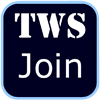

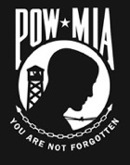

|
|
TWS VOICES
TWS Voices are the personal stories of men and women who served in the US Military and convey how serving their Country has made a positive impact on their lives. If you would like to participate in a future edition of Voices, or know someone who might be interested, please contact TWS Voices HERE.
This edition of Navy Voices was supported by:
Navy.Togetherweserved.com
For current and former serving Members of the United States Navy, TogetherWeServed is a unique, feature-rich resource enabling Naval personnel to re-connect with lost Shipmates, share memories and tell their Navy story.
To join Navy.Togetherweserved.com, please click HERE.
|
|